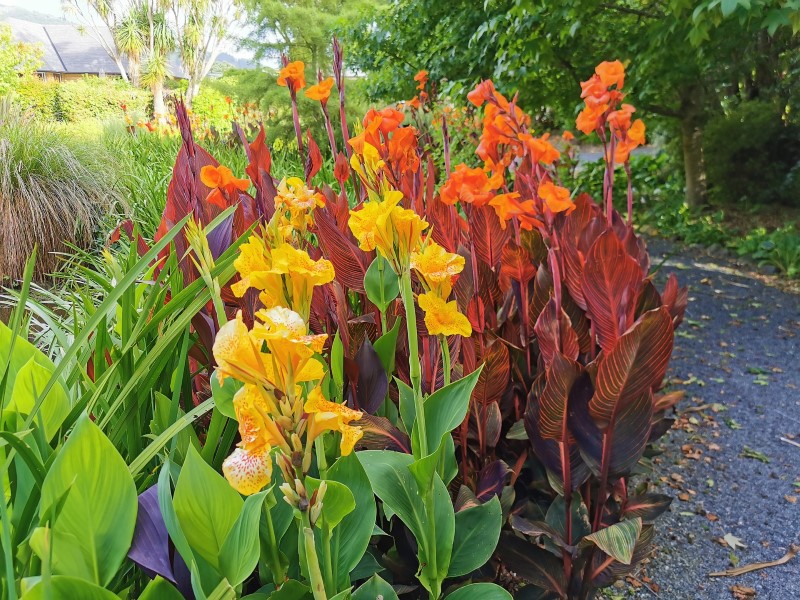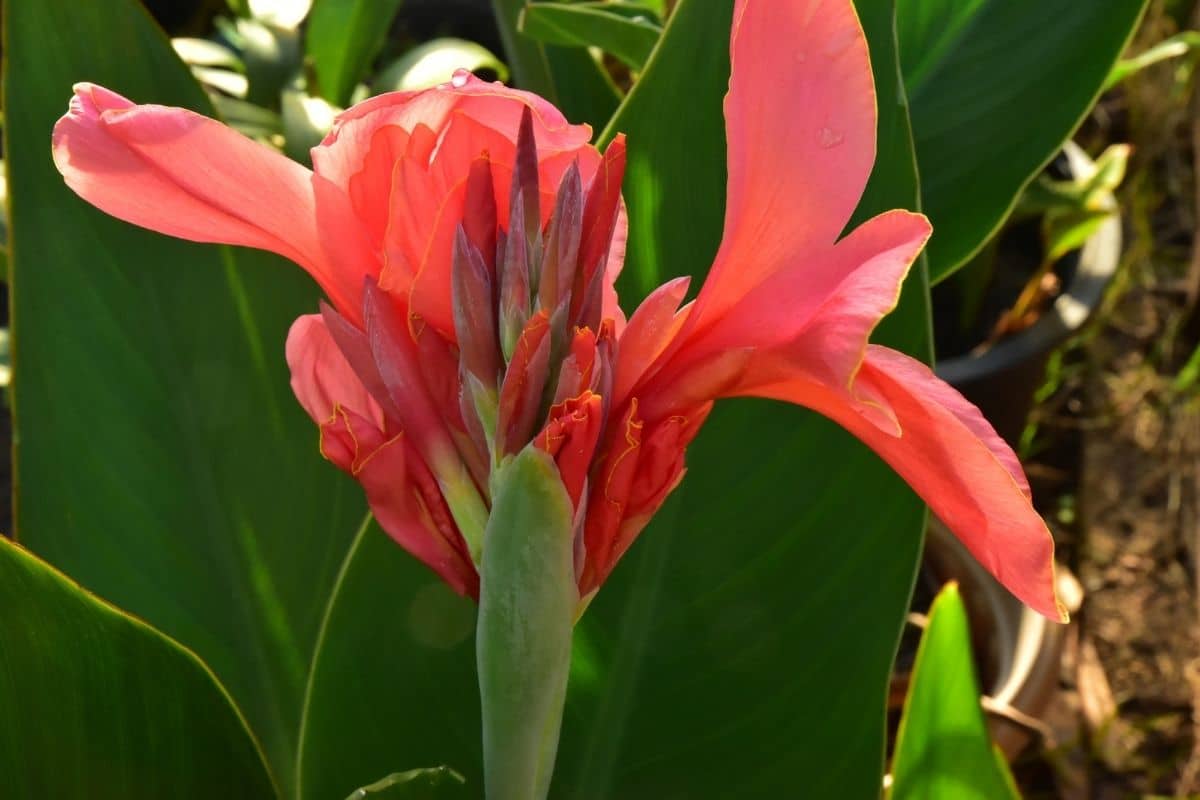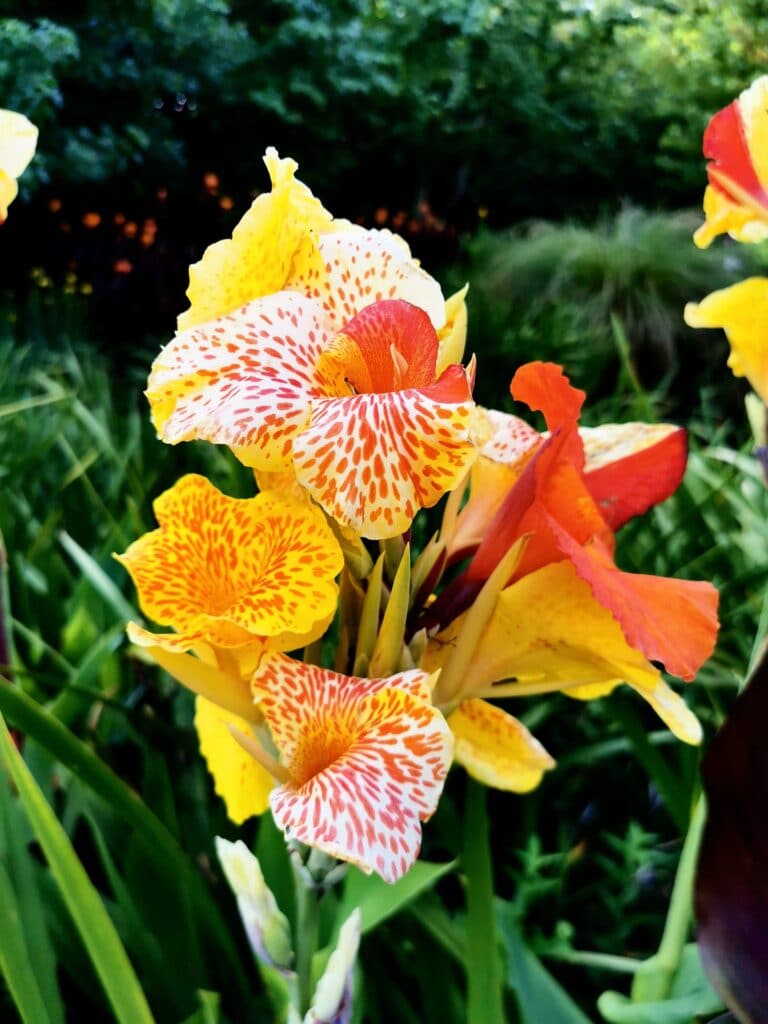The beautiful canna lily, Canna indica, is a perennial favorite in the garden. This plant provides an excellent show of color with its large, dramatic blooms that are easy to grow.
If you want to know how to grow canna plants and get them ready for planting, read on!
What Are Canna Lilies?
Cannas are the only genus of flowering plants that belong to the Cannaceae family. These plants aren’t actually true lilies, as most people believe, but are instead more closely related to plants such as ginger, bananas, arrowroots, birds of paradise, and heliconias.
With their large, dramatic foliage, they are popular garden plants. They are often grown as starches for food (both for animals and humans) and are native to the tropics.
Despite being native to the tropics, though, these yellow flowers spotted with red are often grown in more temperate areas. They can be grown as houseplants but numerous cultivars have been developed to grow in warm climates where at least six to eight hours per day of sunlight is attainable.
The most common variety of canna lily we grow in our gardens is Canna indica, sometimes called achira in Latin America. There are also Canna glauca varieties as well as combinations of the two.
These flowers are native to tropical and subtropical regions of the Americas and have become naturalized in most places. Though most often grown as ornamental plants, either directly in the garden or in pots, they also have many uses in agriculture, jewelry-making, musical instruments, and more. In some parts of India, canna lilies are even fermented to produce alcohol!
A tall plant with tropical-like foliage, the canna lily produces large flowers similar to those of the iris. The plant is considered one of the most low-maintenance and easy to grow, offering attractive and vibrant colors in the garden. Both flower and foliage colors for this plant vary depending on the specific cultivar.

How to grow Cannas lilies
These red orange flowers grow best in full sun with moderate amounts of water, ideally in rich or sandy soil. The plants are best grown from perennial rhizomes but can also be grown as annuals.
Wherever you choose to plant your canna lilies, it’s a good idea to make sure it is relatively sheltered. When it gets extremely windy, the high winds can tear the leaves and flower petals from the plant – so consider planting your flowers against the side of a house or in another sheltered location.
Again, canna lilies are sensitive to frost and will rot if they aren’t protected during cold weather. Plant the sprouted plants outside after the risk of frost has passed in late spring.
If your winter temperatures regularly drop below 14 degrees Fahrenheit, you can dig up the rhizomes or cover them with a thick layer of mulch.
Because of these specific requirements, these plants are typically grown as annuals in cool environments. They love lots of heat and can tolerate partial shade but only if it’s warm enough.

How to Plant Canna Lily
You can propagate cannas by division or seed, though division is arguably the easiest.
Growing with rhizomes is the best way to cultivate these plants. When planting outdoors, make sure the danger of frost has passed. You can plant groups about a foot or two apart.
Planting cannas lilies by division:
- Remove surplus soil around the base of the plant to expose the rhizome (underground stem).
- Cut the rhizome into sections, ensuring each piece has at least three “eyes” (red dots where new growth emerges).
- Insert the rhizome sections horizontally into the garden soil with the eyes facing upwards.
- Cover each section with 3-6 inches of soil.
- Water cannas well and apply mulch with peat moss to retain soil moisture.
Consider planting your canna lilies where they will have the most visual impact during the height of summer. Most cultivars are tall and therefore are best positioned at the back of a raised bed, but that’s not always the case. Full sun is ideal, though, of course.
Canna lilies like a lot of heat, growing well even when temperatures creep into the high 90s! These tropical plants are root-hardy perennials in places where the ground does not freeze.
These kinds of showy flowers prefer soil that is rich and well-draining, ideally with a pH of around 6.5

Caring for Canna Lilies
Cannas are easy to cultivate and don’t require much attention after planting.
Watering
Keep your vibrant tender perennials moist, especially until they are established. At least one to two inches of water per week is ideal to keep the plants looking their best.
Be sure to do some research into how much water is needed by your specific cultivar, though. There are some cannas that prefer to be dry place while others grow best when partially submerged in shallow water!
Fertilizing
Monthly feeding is necessary for most canna cultivars. To stimulate more blooms, feed cannas with a 5-10-5 or 10-10-10 granular fertilizer during the growth season.
These flowers are heavy feeders and need lots of compost or other organic fertilizer to keep the plants looking good. If your plant starts to look a bit tattered or ratty as the summer wears on, it’s time to fertilize. Know that it is very difficult to over-fertilize a canna lily, especially if you are using an organic fertilizer.
Pests and Diseases
For the most part, canna lilies remain free from pests and diseases, which is just one reason why these plants are so popular for gardeners.
One disease to watch out for is canna rust, a fungal disease that causes orange spots to appear on the green leaves of the plant. Generally, this is caused by too wet soil, so it’s important to follow the guidelines for watering and planting listed above.
Occasionally, your plants may also fall prey to various viruses, most of which are specific to the canna genus. These are usually mild, rarely causing death but instead resulting in stunted growth or discolored leaves.
Every now and then, canna lilies might fall victim to a fungal disease called botrytis. This is most common in humid conditions and again, preventing overwatering is your first line of defense in treating this disease. You can also remove old flowers to prevent mold from spreading to new plants.
As for pests, keep an eye out for snails, slugs, and Japanese beetles. All damage plants by chewing large holes in the leaves (or by feasting on their flowers).
Typically, you can reverse or prevent these problems by limiting the use of chemical fertilizers and by amending the soil with lots of high-quality garden compost before you plant. The healthier your plants are, the more resilient they will be when it comes to fending off pest attacks.
Another pest to keep an eye out for is the canna leaf-roller, typically found in the southern portions of the United States. This pest, in moth form, lays eggs in the stalk’s buds. The caterpillars then use a sticky bit of webbing to stop the leaf from unfurling, feeding inside the rolled-up area, and causing serious damage to the plant.
Keep an eye out for these pests when canna lilies are the most vulnerable, typically in the early spring. Open the leaves and remove the caterpillars if you notice them upon inspection of your plants. You can use an insecticide like Bacillus thuringiensis but this is often not necessary unless pest populations are extremely high.
Growing Canna Lilies in Containers
You can even grow canna lilies in containers! If you do this, make sure you choose a pot that is large. This will give your plants all the room they need to grow.
Bear in mind that canna lilies are large plants and will only get bigger. If they become pot-bound, they will lose their vigor. Your plants should be planted in high-quality potting soil and be watered once or twice a day. Keep the pots moist but not soggy.
Because plants grown in containers also leach nutrients more quickly than those grown in the ground, remember that more frequent fertilizing will be necessary, too. Aim to fertilize about twice as often using a water-soluble or slow-release granular fertilizer.
Other Growing Tips
One final tip for growing canna lilies? Make sure you dig up and store the canna rhizomes in the fall if you live in colder climates.
If you don’t do this, your other option is to let the plants overwinter in pots so that they can grow throughout the late winter months. Once the weather warms up, you can replant them in the garden or just move them back outdoors. You may also choose to divide the plant at this time, if desired.
Pruning is not necessary with canna lilies but again, if your plant is looking a bit tattered, just cut the plants to the ground, add water and fertilizer, and wait for them to recover. This can be done at any time of the year, even in midsummer.
For companion planting and landscaping ideas, check these canna lily companion plants you can grow.
Common Types of Cannas

Almost all cannas grown by gardeners are cultivars, with about 20 species existing in the wild form. Cannas were extremely popular in the Victorian days as garden plants and there are many cultivars from this period that are still available.
Cannas get their name from the Greek word “kanna” and the Celtic “cana,” which refer to “a reed-like plant” and are closely related to the musical word “canon.”
The most common wild species of canna lilies you will find include:
- Canna bangii
- C. flaccida
- C. glauca (the most common variety used in modern cultivars, since it can tolerate wet conditions a bit better than others)
- C. indica (the most popular agricultural variety)
- C. iridiflora
- C. jaegeriana
- C. liliiflora
- C. paniculata
- C. pedunculata
- C. tuerckheimii
- C. amabilis
- C. coccinea
- C. compacta
- C. discolor
- C. jacobini flora
- C. patens
- C. pluri tuberosa
- C. speciosa
- C.stenthta
Of these, there are a few cultivars that are considered to be the most popular among home gardeners.
Canna indica ‘Red Stripe’ is one such example. This plant has 8’ tall stalks that boast nearly two-foot-long leaves, typically in purple, with dramatic green patterns between the veins. The canna flowers are small but a bright, noticeable red.
Another common variety is Canna iridiflora, or Peruvian canna. This species has been used almost exclusively as a parent plant in creating most modern canna hybrids. It’s extremely tall, growing up to sixteen feet tall, with pink pendulous flowers that appear later in the season.
Some other canna lily cultivars to consider for your garden include:
- ‘Apricot Dream’
- ‘Australia’
- ‘Bengal Tiger”
- ‘Pink Sunburst’
- ‘Thai Rainbow’
- ‘Nuance’
- ‘Kansas City’
There are hundreds of options out there, so be sure to keep looking until you find the one that’s perfect for your needs.
FAQs
Do canna lilies come back every year?
Yes, canna lilies (Canna indica) are perennial plants, and under favorable conditions, they can come back every year from their rhizomes.
How do you care for canna lilies after they bloom?
After canna lilies bloom, remove spent flowers to encourage continuous blooming. Additionally, consider deadheading to improve the overall appearance of the plant and redirect energy toward new growth and blooming.
Do canna lilies need to be cut back?
Canna lilies benefit from cutting back in late fall or early winter. Once frost date has caused the foliage to die back, trim the stems to about 4-6 inches above the soil level. This helps prepare the plant for winter dormancy.
How do you keep canna lilies blooming all season?
To keep canna lilies blooming throughout the season, provide them with full sun, well-draining, slightly acidic soil, and regular watering. Applying a balanced fertilizer every 4-6 weeks during the growing season can promote robust flowering. Deadhead spent blooms promptly to encourage the development of new flowers.
Final thoughts
By mastering the key elements of canna lily care – ample sunlight, consistent moisture, regular feeding, and a touch of winter protection – you can unlock these vibrant beauties’ full potential.
Witnessing their dazzling blooms grace your garden season after season will be a testament to your attentive care, transforming your space into a tropical paradise. So, embrace the rhythm of canna lily care, and prepare to be captivated by their mesmerizing display!
*image by AekPN/depositphotos







